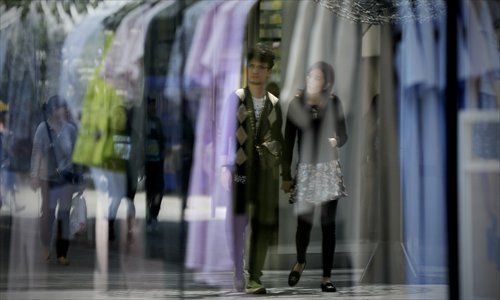China scores back-to-back exports growth
Trade structure needs optimization in face of export challenges

A couple is reflected on a shop window as they walk past a clothing store in Beijing on Sunday. China's exports in yuan-denominated terms grew 4.1 percent in April. Photo: AFP
China's exports in yuan-denominated terms rose for a second consecutive month in April, mainly driven by rising domestic demand, but a substantial level of growth seems unlikely in the future due to sluggish global trade, experts noted.
Exports in yuan-denominated terms grew 4.1 percent in April from the same period last year to 1.13 trillion yuan ($173.9 billion), data released by the General Administration of Customs (GAC) showed on Sunday.
Imports hit 827.5 billion yuan in April, dipping 5.7 percent on a yearly basis, according to GAC data. That led to a monthly trade surplus of 298 billion yuan, up from March's 194.6 billion yuan.
"Increased investments in domestic infrastructure projects during this period boosted domestic demand, which in turn strengthened trade," Xu Hongcai, director of the Economic Research Department of the China Center for International Economic Exchanges, told the Global Times Sunday.
Overseas investments exceeded $40 billion in the first quarter this year, which helped April exports, Xu noted.
The momentum in China's trade will probably continue in the next two months, but extended growth seems unlikely due to the country's current industrial structure as well as sluggish global demand, he said.
Bai Ming, a research fellow at the Chinese Academy of International Trade and Economic Cooperation, said that April trade figures were strong due to a comparatively low base number in 2015.
"The rising momentum has not firmed up, and I expect a slight drop in the future," Bai told the Global Times Sunday.
Though April figures point to a rebound, challenges still remain since trade declined in the first four months, according to experts.
Exports dipped 2.1 percent on a yearly basis, and imports declined 7.5 percent, data shows.
"The country still faces many challenges in trade because the trade environment has not changed and the spillover in domestic demand rarely happens," Bai said.
Though the price for bulk commodities declined in the global markets, some imports continued to drop as well, he noted.
Imports of coal, steel and refined oil declined in the first four months, down 2.5 percent, 4.6 percent and 1.2 percent from the previous year, respectively, the GAC data shows.
Also, the domestic market is trying to adapt to the new policy on cross-border e-commerce business, which also put short-term pressure on imports, according to Bai.
In early April, the central government imposed a new tax on overseas purchases to clamp down on them and encourage domestic spending.
Other external factors also affected China's exports - protectionism persists and the momentum appears to be growing, especially toward steel and photovoltaic products, noted Xu.
The government is trying to create a sound environment for trade by rolling out more proactive fiscal and trade measures," Lian Ping, chief economist at the Bank of Communications, was quoted as saying in a note sent to the Global Times on Sunday.
Given that China's economic growth slowed to 6.7 percent in the first quarter, the weakest since the global financial crisis, Lian said that the recent pick-up in industrial output will promote trade to some extent in the near future.
Optimizing trade structure
China's trade structure needs to be further optimized in a bid to deal with challenges facing exports, Xu said, noting that "focus should be shifted from exporting low-end goods to mid-to-high end goods, such as providing more services and technology trading."
Overseas investments should also be promoted, increasing exports in countries and regions along the Belt and Road initiative thanks to ample investment opportunities there, Xu said.
China is expected to be more open to the global investors through continuous free trade agreement discussions to establish a free trade zone network, noted Xu.